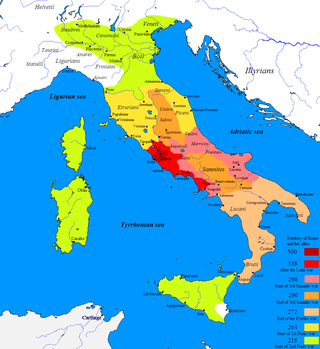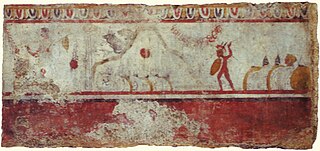Year 321 BC was a year of the pre-Julian Roman calendar. At the time, it was known as the Year of the Consulship of Calvinus and Caudinus. The denomination 321 BC for this year has been used since the early medieval period, when the Anno Domini calendar era became the prevalent method in Europe for naming years.

The First, Second, and Third Samnite Wars were fought between the Roman Republic and the Samnites, who lived on a stretch of the Apennine Mountains south of Rome and north of the Lucanian tribe.

Samnium is a Latin exonym for a region of Southern Italy anciently inhabited by the Samnites. Their own endonyms were Safinim for the country and Safineis for the people. The language of these endonyms and of the population was the Oscan language. However, not all the Samnites spoke Oscan, and not all the Oscan-speakers lived in Samnium.
Quintus Fabius Maximus Rullianus was a patrician, politician and soldier of the Roman Republic during the fourth and early third century BC. He was the son of Marcus Fabius Ambustus, of the patrician Fabii, was five times consul, dictator once, censor, and a hero of the Samnite Wars. He was brother to Marcus Fabius Ambustus, who was named after their father, and the grandfather of Quintus Fabius Maximus Verrucosus.
The gens Pontia was a plebeian family at ancient Rome. Few members of this gens rose to prominence in the time of the Republic, but the Pontii flourished under the Empire, eventually attaining the consulship. Pontius Pilatus, as prefect of Judaea, is known for his role in the execution of Jesus.

The Battle of Caudine Forks, 321 BC, was a decisive event of the Second Samnite War. Its designation as a battle is a mere historical formality: there was no fighting and there were no casualties. The Romans were trapped in an enclosed valley by the Samnites before they knew what was happening and nothing remained but to negotiate an unfavorable surrender. The action was entirely political, with the magistrates on both sides trying to obtain the best terms for their side without disrespecting common beliefs concerning the rules of war and the conduct of peace. In the end the Samnites decided it would be better for future relations to let the Romans go, while the Romans were impeded in the prosecution of their campaign against the Samnites by considerations of religion and honor.

The Battle of Mount Gaurus, 343 BC, was the first battle of the First Samnite War and also the first battle fought between the Roman Republic and the Samnites. The battle is described by the Roman historian Livy as part of Book Seven of his history of Rome, Ab Urbe Condita Libri, where he narrates how the Roman consul Marcus Valerius Corvus won a hard-fought battle against the Samnites at Mount Gaurus, near Cumae, in Campania. Modern historians however believe that most, if not all, of the detail in Livy's description has been invented by him or his sources.

Lucius Papirius Cursor was a celebrated politician and general of the early Roman Republic, who was five times consul, three times magister equitum, and twice dictator. He was the most important Roman commander during the Second Samnite War, during which he received three triumphs.

The Battle of Lautulae was fought in 315 BC during the Second Samnite War, opposing the Roman Republic and the Samnites, who defeated the Romans.

The (Second) Latin War of 340–338 BC was a conflict between the Roman Republic and its neighbors, the Latin peoples of ancient Italy. It ended in the dissolution of the Latin League and incorporation of its territory into the Roman sphere of influence, with the Latins gaining partial rights and varying levels of citizenship.
Quintus Fabius Q. f. M. n. Maximus Gurges, the son of Quintus Fabius Maximus Rullianus, was consul in 292, 276, and 265 BC. After a dissolute youth and a significant military defeat during his first consulate, he was given the opportunity to salvage his reputation through the influence of his father, and became a successful general, eventually holding the highest honours of the Roman state. He was slain in battle during his third and final consulate.

The Battle of Suessula was the third and last battle between the Samnites and the Roman Republic in 343 BC, the first year of the First Samnite War. According to the Augustan historian Livy, the Samnites gathered their army at Suessula, at the eastern edge of Campania. The Roman consul Marcus Valerius Corvus took his army by forced marches to Suessula. When the Samnites had to scatter their army to forage for food, Valerius seized the opportunity to capture the Samnite camp and then rout the Samnite foragers. Modern historians believe that details of the battle were entirely invented by Livy and his annalistic sources, and the battle's historicity has also been questioned.
The military campaigns of the Samnite Wars were an important stage in Roman expansion in the Italian Peninsula.
Caudium was the main city of the ancient Caudini tribe in Samnium situated on the Appian Way between Beneventum and Capua, in what is now southern Italy. It was 21 Roman miles from Capua, and 11 from Beneventum. It, or nearby Arpaia, became the seat of an early bishopric, which is now a Latin Catholic titular see.
Spurius Postumius Albinus Caudinus was a politician of Ancient Rome, of patrician rank, of the 4th century BC. He was consul in 334 BC, and invaded, with his colleague Titus Veturius Calvinus, the country of the Sidicini. But on account of the great forces which the enemy had collected, and the report that the Samnites were coming to their assistance, a dictator was appointed, Publius Cornelius Rufinus.

Lucius Postumius Megellus was a politician and general during the middle years of the Roman Republic. Reportedly an arrogant and overbearing man, he was elected consul in 305 BC. The Second Samnite War was ongoing, and as consul he led troops against the Samnites. He defeated them at the Battle of Bovianum and took the town of Bovianum, which caused the Samnites to sue for peace, ending the war. Megellus was awarded a triumph.

The Battle of Saticula, 343 BC, was the second of three battles described by the Roman historian Livy, in Book Seven of his history of Rome, Ab Urbe Condita, as taking place in the first year of the First Samnite War. According to Livy's extensive description, the Roman commander, the consul Aulus Cornelius Cossus was marching from Saticula when he was almost trapped by a Samnite army in a mountain pass. His army was only saved because one of his military tribunes, Publius Decius Mus, led a small group of men to seize a hilltop, distracting the Samnites and allowing the consul to escape. During the night Decius and his men were themselves able to escape. The next day the reunited Romans attacked the Samnites and completely routed them. Several other ancient authors also mention Decius' heroic acts. Modern historians are however sceptical of the historical accuracy of Livy's account, and have in particular noted the similarities with how a military tribune is said to have saved Roman army in 258 BC during the First Punic War.

The gens Herennia was a plebeian family at ancient Rome. Members of this gens are first mentioned among the Italian nobility during the Samnite Wars, and they appear in the Roman consular list beginning in 93 BC. In Imperial times they held a number of provincial offices and military commands. The empress Herennia Etruscilla was a descendant of this gens.
Pontius Telesinus was the last independent leader of the Italic Samnites before their annexation by the Roman Republic. A fierce patriot, he was one of the rebel commanders in the Social War against Rome, leading the last remnants of the rebellion in southern Italy after the main uprising had already been suppressed. He intervened in the Roman civil wars of the 80s BC in an attempt to improve his and his people's position, but picked the losing side and was killed in 82 BC following the Battle of the Colline Gate against the Roman general Sulla.
Gaius Sulpicius Longus was an accomplished general and statesman of the Roman Republic who served as Consul thrice and dictator once during his career, triumphing once over the Samnites and achieving great political success.










